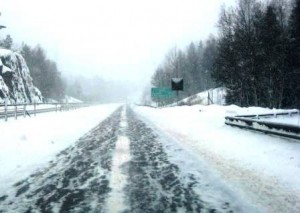Now that winter is firmly entrenched in our northern latitudes, drivers are trying to cope with the ice, snow, and other hazards that turn roads treacherous and contribute to the more than 1.5 million annual weather-related car crashes, according to the National Research Council.
Teen drivers, many of whom facing wintry conditions behind the wheel for the first time, need guidance to safely navigate the roadways through the upcoming months. To help, Liberty Mutual Insurance has a host of winter safety resources for teens click here. And if TDB’s experience is representative, more than teens need to think about navigating a two-ton car through the slop.
“Driving in wintry conditions is no easy task, even for seasoned drivers, and it is especially difficult for younger drivers with limited experience to adapt to slippery roads and poor visibility,” said Dave Melton, a driving safety expert with the Liberty Mutual Research Institute for Safety.
“Teen drivers need to take extra steps to protect themselves this winter, and parents need to promote and enforce safe driving habits to keep their teens safe.”
Before getting behind the wheel, a driving safety video at the site will help teens and parents get winter road-ready and ensure their cars are safe and in good working order.
Website visitors also will find car maintenance tips and a checklist for a winter driving safety kit. These tips include:
- Before you get on the road in bad weather, check your local news stations and their websites for detailed, up-to-the-minute weather and traffic information.
- If your trip is absolutely necessary, give yourself extra time.
- During inclement weather put extra distance – at least five or six seconds -between yourself and the vehicle in front.
- Antilock brakes, all-wheel and four-wheel drive won’t help you stop faster.
- Turn on your headlights so other drivers can see you. In snow, fog and rain, don’t use high beams – they increase glare for both you and other drivers.
- Signal your intentions early; don’t surprise other drivers.
- Do not use cruise control when roads are hazardous.
- And, slow down!
- Did we mention slow down!
This looks to be good driving safety advice for any season, but even more so during the winter: car crashes are 36% more likely to happen in January than July, according to the National Highway Traffic Safety Administration.
Add in unsafe or distracted driving behaviors reported by teen drivers in a recent study by Liberty Mutual and Students Against Destructive Decisions, including speeding (39%), talking on a cell phone (37%) and text messaging (30%), and winter roadways become even more dangerous for all
Since 1991, Liberty Mutual and SADD have collaborated on research and responsible solutions to keep families safe behind the wheel, including the resources found here such as:
- fun and easy ways for teens to brush up on basic driving skills such as following street signs, mastering parallel parking, and managing wet roads;
- video demonstrations on safe driving techniques;
- information on state-by-state driving laws;
- a safe driving quiz that challenges teens to think about their driving skills and compete with their parents or friends;
- a customizable parent/teen safe driving contract with customizable family ground rules around key safe driving issues such as speeding, the number of passengers in the car, cell phone usage, texting while driving, and curfews;
- tips on how to talk to teens about driving distractions and dangers;
- tips on buying and caring for a car, individual car safety scores;
- and, an exclusive 50 percent discount for teens to take the National Safety Council’s online Defensive Driving Course.



Having taught 4 teenagers to drive in the snow, I have found one of the best things I can do to ensure their safety is to have good winter tires on the vehicles they drive.
AutoNetTV has a short video on winter tires. http://autonettv.com/2009/winter-tires.html
Thanks. Nice addition and worth looking at.